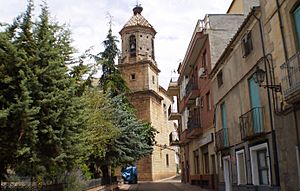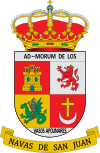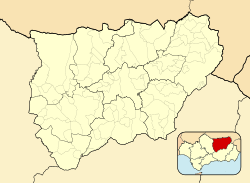Navas de San Juan facts for kids
Quick facts for kids
Navas de San Juan, Spain
|
||
|---|---|---|
 |
||
|
||
| Country | ||
| Autonomous community |
||
| Province | ||
| Municipality | Navas de San Juan | |
| Comarca | El Condado | |
| Area | ||
| • Total | 175 km2 (68 sq mi) | |
| Elevation | 654 m (2,146 ft) | |
| Population
(2018)
|
||
| • Total | 4,555 | |
| • Density | 26.03/km2 (67.41/sq mi) | |
| Demonym(s) | Navero | |
| Time zone | UTC+1 (CET) | |
| • Summer (DST) | UTC+2 (CEST) | |
| Area code(s) | (+34) 953 68 XX XX | |
Navas de San Juan is a charming village in the province of Jaén, Spain. It's located in the beautiful region of El Condado. A river called Guadalimar flows through its area.
The village has a special protector, Saint John the Baptist, whose festival is celebrated from June 24th to 29th. Another important figure is the Virgin de la Estrella. Her pilgrimage is a big event held at her shrine on May 1st, 2nd, and 3rd.
Contents
Ancient Beginnings
People have lived in the area of Navas de San Juan for a very long time. We know this from settlements like Castellón and La Atalaya, which date back to the middle of the Bronze Age (around 2000 BC). The village itself likely started around the 4th century BC. This was during the Iberian period, possibly helped by the large Iberian city of Cástulo.
During Roman times, Navas de San Juan was an important stop. It was on the road between Cástulo and Ilugo. Old milestones found in the area show this. There was even a Roman "mansion" or inn called Ad Morum here. It was a resting place on the famous Camino de Aníbal road. Many Roman farms, called villas, were also found in the area. Seven of these have been recorded, like El Acero.
Medieval Times and Castles
When the Moors ruled Al-Andalus, Navas de San Juan was a small village called an alquería. It was part of the Sant Astiban district. The Muslims built a castle here, but only pictures of it remain today. Christians later rebuilt parts of it. Other old forts are also found nearby, like the castle of Ero. There's also a tower keep where the shrine of Santa María de la Estrella now stands.
Ferdinand III of Castile conquered these lands in 1226. They became part of the royal lands under Santisteban del Puerto. Later, in 1254, King Alfonso X gave Santisteban del Puerto to the city of Úbeda. But in 1285, King Sancho IV made Santisteban and its area royal lands again.
In the 14th century, Navas de San Juan and Castellar became a special area called the lordship of Santisteban. This was given by Henry II to Men Rodríguez Benavides. In 1473, Henry IV made it a county, giving Don Diego Sánchez de Benavides the title of Count of Santisteban.
Modern Era and Independence
In 1793, Philip V made the area a dukedom. It was given to the House of Medinaceli. Navas de San Juan was connected to Santisteban del Puerto for a long time. This changed in 1802 when Charles IV gave Navas de San Juan its own royal charter. This meant it became an independent town.
20th Century Changes
In the mid-20th century, like many other places in Andalusia, Navas de San Juan saw many people move away. They left the countryside for bigger cities. Between 1940 and 1975, the village lost about 25% of its population.
Explore Monuments and Important Places
At the start of the 20th century, a castle still stood in the village. Sadly, it was torn down, and nothing remains of it today. However, you can still find some Roman road and settlement remains in the area.
Saint John Baptist Church
The Saint John Baptist Church was built between the 16th and 18th centuries. It has a beautiful front in the Mannerist style. Its tower was built in the 17th century.
Virgen de la Estrella Chapel
The Chapel of the Virgen de la Estrella was built around the same time as the church. It stands on an old medieval fort. Only the Tower Keep from that fort remains. This tower is considered a place of Tourist Interest.
Town Hall and Other Buildings
The Town Hall building dates back to the late 19th century. It has a striking brick front, a clock, and a bell tower. Also from the late 19th century is the Asilo de Santa Sara y San Fructuoso. This building has a mix of styles and modern decorations.
Local Traditions and Festivals
Popular Local Holidays
- May 1st, 2nd, and 3rd: Pilgrimage to the Virgen de la Estrella. This event was declared a Tourist Interest in 1984. People gather around the virgin's chapel, which is about 5 km from the village. It's one of the most important pilgrimages in the province. Pilgrims from all over Spain come to honor "La Reina Del Olivar" (The Queen of the Olive Grove). During the evening of May 3rd, the image is brought to the village in a procession. It stays there until the first Saturday of September, when it returns to its chapel. People sing traditional "Mayos" music during this time.
- June 23rd–29th: Saint John's Day Celebration. This is a week of festivities held since 1808. It honors the village's patron saint, Saint John the Baptist. These celebrations have a strong bullfighting tradition. You can see encierros (running of the bulls), corridas (bullfights), and novilladas (young bullfights). In the evenings, there are popular and lively night festivals called verbenas.
- First Weekend of August: Emigrants Festival. This three-day celebration was created for people who live outside the village. It allows them to enjoy a smaller version of the Saint John's Day Celebration if they couldn't attend in June.
The main part of the region's economy comes from olive trees. Large areas are covered with olive groves. The village produces millions of kilograms of olives each year. These are processed in five large local oil mills.
There is also some livestock farming, mainly cattle. Hunting for both large and small game is also important for the local economy. Another key resource is the itinerant fairs. These fairs travel around and create many jobs during the summer.
Delicious Local Food
The food in Navas de San Juan is influenced by the cooking of La Mancha. This is because of its close location. Traditional dishes like porridge or ratatouille are common.
However, there are also unique local recipes, especially sweets and desserts. These include pericones (originally from Arquillos), pollas en leche, and gachas dulces. Other notable dishes are calandrajos and pipirrana, as well as local sausages.
The Village and Its Surroundings
The village of Navas de San Juan sits on a flat area called a nava, about 630 meters above sea level. It is surrounded by the rivers Guarrizas, Guadalén, and Guadalimar.
The old town has winding streets that started around where the Moorish castle once stood. From this center, the village grew outwards. It developed into the Plaza de la Iglesia and Plaza de la Constitución (also known as Plaza de las Palmeras). These squares are now the main social hubs of the town.
The town also has examples of medieval and noble architecture. The Saint John Baptist's Parish Church is one such example. Some historians believe the church might have originally been the feudal castle of the Benavides family. This is supported by the building's architectural styles. There are also stories of underground passages connecting it to other old buildings and a well.
See also
 In Spanish: Navas de San Juan para niños
In Spanish: Navas de San Juan para niños





